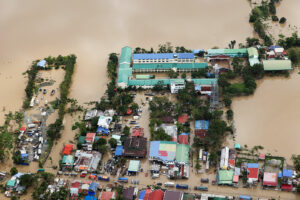




Quarterly Economic Growth Release: More BSP cuts to come
 DOWNLOAD
DOWNLOAD

Monthly Economic Update: Fed catches up
 DOWNLOAD
DOWNLOAD

Inflation Update: Steady and mellow
 DOWNLOAD
DOWNLOAD


Disasters, debt crisis are seen as top risks for PHL

NATURAL DISASTERS are considered the top risk faced by the Philippines over the next two years, alongside a possible debt crisis, rising inflation and misinformation, according to a survey conducted by the World Economic Forum (WEF).
In its Global Risks Report 2023, the WEF said Philippine respondents for its executive opinion survey (EOS) identified natural disasters and extreme weather events as the top risk facing the country.
The Philippines is one of the countries considered most vulnerable to natural disasters such as earthquakes, floods, heatwaves, and typhoons. It had the highest disaster risk among 193 countries in the World Risk Index last year.
“Natural disasters and calamities cause a lot of damage, disruption, and productivity losses in a year and is a consideration for investments,” Rizal Commercial Banking Corp. Chief Economist Michael L. Ricafort said in a Viber message when sought for comment.
Philippine respondents also considered a debt crisis as the second-biggest risk, as the government borrowed heavily to fund its coronavirus pandemic response.
The National Government’s outstanding debt stood at a record P13.644 trillion as of end-November. As of end-September, the government’s debt-to-gross domestic product (GDP) stood at 63.7%, still above the 60% threshold prescribed by multilateral lenders.
However, Mr. Ricafort said that the country’s debt-to-GDP ratio is still manageable.
“However, there is a need to bring the debt-to-GDP ratio to below the international threshold of 60% of GDP… to prevent any risk of credit rating downgrade,” Mr. Ricafort said.
MISINFORMATION
The WEF report showed Philippine respondents also identified rapid or sustained inflation, misinformation, and geopolitical contestation of resources as other top risks for the country.
Inflation rose to a 14-year high of 8.1% in December, bringing the full-year average to 5.8%. However, the Philippine central bank sees inflation easing to 4.5% this year and 2.8% in 2024.
Based on the WEF report, the Philippines was the only country where respondents considered misinformation as one of the top five risks in the next two years.
“Misinformation and disinformation are, together, a potential accelerant to the erosion of social cohesion as well as a consequence. With the potential to destabilize trust in information and political processes, it has become a prominent tool for geopolitical agents to propagate extremist beliefs and sway elections through social media echo chambers,” WEF said.
Filipino voters had faced a barrage of fake news on social media, particularly during the national elections in 2016 and 2022.
“Information is key to any good working economy. Information asymmetry is not good especially for financial markets,” UnionBank of the Philippines, Inc. Chief Economist Ruben Carlo O. Asuncion said in a Viber message.
Mr. Ricafort said that misinformation is a high risk for the Philippines since it could affect both the economic and political landscape.
“It could potentially alter election results/voters’ behavior and choices. It is also important in view of the information age… Increased education and transparency can help address risk of misinformation,” he added.
Mr. Asuncion said the Philippine government has a “tough task” of sustaining economic recovery amid various headwinds.
“Nevertheless, we do have a leg up moving forward but still I would approach 2023 with much caution… Global economic growth is fragile and any unexpected event (like geopolitical noise, resurgence of COVID-19) can push the global economy into a deeper economic slowdown,” Mr. Asuncion said.
“Careful and deliberate policy coordination and support would be welcome amidst the challenges of uncertainties that we all face as citizens of this world,” he added.
The survey was conducted by WEF between April and September 2022. It involved over 12,000 respondents from WEF’s partner institutes, who were asked which five risks are most likely to pose the biggest threat to their country in the next two years.
GLOBAL RISKS
Meanwhile, the “cost-of-living crisis” was ranked as the most severe global risk in the next two years, the annual WEF Global Risks Perception Survey (GRPS) showed.
“The persistence of a global cost-of-living crisis could result in a growing proportion of the most vulnerable parts of society being priced out of access to basic needs, fueling unrest and political instability,” WEF said.
Other top global risks identified by global respondents were natural disasters and extreme weather events; geoeconomic confrontation, failure to mitigate climate change; and erosion of social cohesion and societal polarization.
Global risk is defined by the possibility of the occurrence of an event that may negatively impact a significant proportion of global economy, population or natural resources.
In the next 10 years, the failure to mitigate climate change is seen as the biggest risk facing the global economy, followed by failure of climate change adaption, and natural disasters and extreme weather events.
“The short-term risk landscape is dominated by energy, food, debt and disasters. Those that are already the most vulnerable are suffering — and in the face of multiple crises, those who qualify as vulnerable are rapidly expanding, in rich and poor countries alike,” WEF Managing Director Saadia Zahidi said in a separate statement.
“Climate and human development must be at the core of concerns of global leaders, even as they battle current crises. Cooperation is the only way forward,” she added.
The GRPS collected responses from over 1,200 experts between Sept. 7 and Oct. 5, 2022. — Revin Mikhael D. Ochave
This article originally appeared on bworldonline.com





 By BusinessWorld
By BusinessWorld